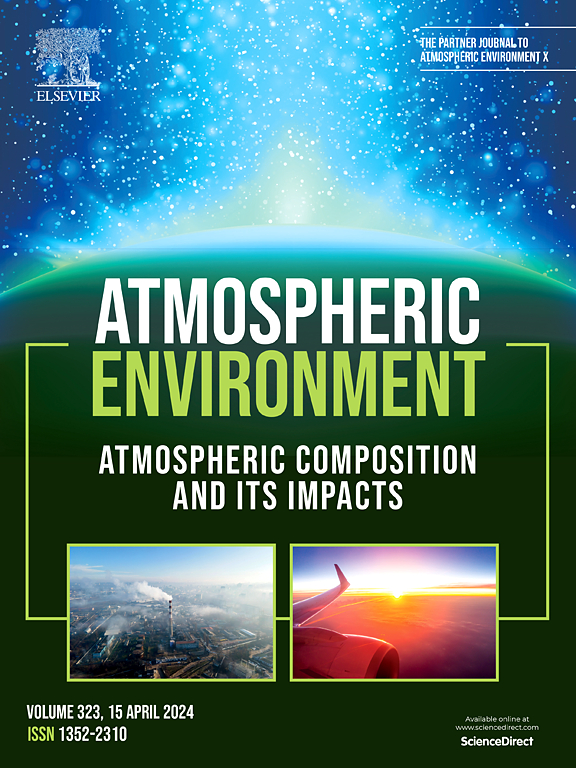Atmospheric oxidation of long chain aldehydes: OH and Cl reactivity, mechanisms and environmental impact
IF 3.7
2区 环境科学与生态学
Q2 ENVIRONMENTAL SCIENCES
引用次数: 0
Abstract
The relative-rate technique has been used to obtain the rate coefficients for the reactions of the saturated aldehydes (SA): Octanal (OCT) CH3(CH2)6C(O)H and Nonanal (NON) CH3(CH2)7C(O)H with OH radicals and Cl atoms at (298 ± 3) K and atmospheric pressure. The experiments were performed in an environmental chamber using in situ FTIR spectroscopy detection to monitor the decay of the aldehydes relative to different reference compounds. The following room temperature rate coefficients (in units of cm3 molecule−1 s−1) were obtained: k1 (OH + CH3(CH2)6C(O)H) = (3.13 ± 0.50) × 10−11, k2 (Cl + CH3(CH2)6C(O)H) = (2.80 ± 0.31) ×10−10, k3 (OH + CH3(CH2)7C(O)H) = (2.81 ± 0.40) × 10−11 and k4 (Cl + CH3(CH2)7C(O)H) = (3.10 ± 0.30) × 10−10. In addition, product studies were performed in similar conditions of the kinetic experiments by the SPME-GC-MS technique. Heptanal, hepta-1-ol, octanoic acid, octanal, 1-octanol, octanoyl chloride, 1-chlorooctane and formaldehyde were identified as reaction products.
The atmospheric implications of the studied reactions were assessed by the estimation of the tropospheric lifetimes of OCT and NON concerning their reaction with OH radicals and Cl atoms to be 9, 10 h and 30, 27 h, respectively. The relatively short residence in the atmosphere of the SA studied will have a local impact with restricted transport. High tropospheric ozone creation potential of 68 and 66 were estimated for OCT and NON, respectively.

长链醛的大气氧化:OH和Cl的反应性、机制和环境影响
用相对速率法计算了饱和醛(SA):辛醛(OCT) CH3(CH2)6C(O)H和壬醛(NON) CH3(CH2)7C(O)H在(298±3)K和常压下与OH自由基和Cl原子的反应速率系数。实验在环境室中进行,使用原位FTIR光谱检测来监测醛类相对于不同参比化合物的衰变。下面的室温率系数(单位立方厘米−1 s的分子−1)得到:k1(哦+ CH3 (CH2) 6 c (O) H) =(3.13±0.50)×10−11,k2 (Cl + CH3 (CH2) 6 c (O) H) =(2.80±0.31)×10−10,k3(哦+ CH3 (CH2) 7 c (O) H) =(2.81±0.40)×10−11和k4 (Cl + CH3 (CH2) 7 c (O) H) =(3.10±0.30)×10−10。此外,在类似动力学实验条件下,采用SPME-GC-MS技术对产物进行了研究。确定了正己烷、正己烷-1-醇、辛酸、辛烷、1-辛醇、辛酰氯、1-氯辛烷和甲醛为反应产物。通过估算OCT和NON与OH自由基和Cl原子反应的对流层寿命分别为9,10 h和30,27 h,评估了所研究反应的大气意义。在研究的SA大气中相对较短的居住时间将在交通受限的情况下产生局部影响。OCT和NON的对流层高臭氧创造势分别为68和66。
本文章由计算机程序翻译,如有差异,请以英文原文为准。
求助全文
约1分钟内获得全文
求助全文
来源期刊

Atmospheric Environment
环境科学-环境科学
CiteScore
9.40
自引率
8.00%
发文量
458
审稿时长
53 days
期刊介绍:
Atmospheric Environment has an open access mirror journal Atmospheric Environment: X, sharing the same aims and scope, editorial team, submission system and rigorous peer review.
Atmospheric Environment is the international journal for scientists in different disciplines related to atmospheric composition and its impacts. The journal publishes scientific articles with atmospheric relevance of emissions and depositions of gaseous and particulate compounds, chemical processes and physical effects in the atmosphere, as well as impacts of the changing atmospheric composition on human health, air quality, climate change, and ecosystems.
 求助内容:
求助内容: 应助结果提醒方式:
应助结果提醒方式:


